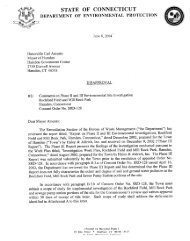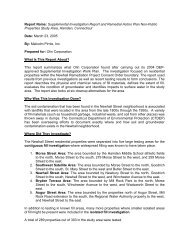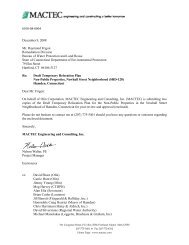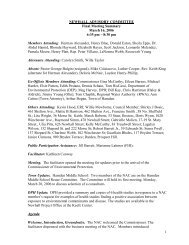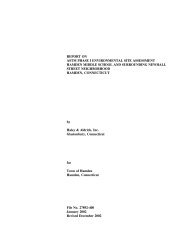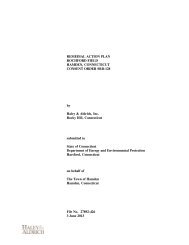Main Report - Newhall Remediation Project
Main Report - Newhall Remediation Project
Main Report - Newhall Remediation Project
- No tags were found...
You also want an ePaper? Increase the reach of your titles
YUMPU automatically turns print PDFs into web optimized ePapers that Google loves.
well below the EPA reference dose (RfD) for oral exposure to PAHs. The RfD is an estimate ofthe “safe dose,” below which, adverse noncancer health effects are not likely. That meansharmful noncancer health effects from PAH exposure are not likely. Refer to Attachment G fordetailed risk calculations.Because some PAHs are believed to cause cancer in humans, CT DPH also calculated theoreticalcancer risks from exposure using the same exposure assumptions described for the arsenic cancerrisk calculations. Detailed calculations are found in Attachment G. The theoretical cancer riskfrom PAH exposure of 8 x 10 -5 (eight excess cancer cases per 100,000 exposed people)represents a non-meaningful incremental risk above the background cancer level ofapproximately one in three (NCI 2001). Additionally, the estimated PAH dose to residents in theBryden Terrace Property Group is more than 200,000 times lower than PAH doses from thecancer effect levels (CELs) in the scientific literature that have been observed to cause cancer inhumans and animals (ATSDR 1995). Because the dose from the site is much lower than theCELs for PAHs, cancer effects are considered very unlikely.Pesticides and ETPHPesticides and extractable total petroleum hydrocarbons (ETPH) were the only othercontaminants found at levels exceeding health-based comparison values in surface soil. Thesegroups of contaminants were found at elevated levels in the samples collected from right-of-wayareas adjacent to yards (see Table 1). Four pesticides (chlordane, heptachlor, beta-hexachlorocyclohexane,and dieldrin) were detected very infrequently. When average levels are calculatedfor these pesticides, the averages are well below health-based comparison values. The same istrue for ETPH. Therefore, CT DPH concludes that health impacts from exposure to pesticidesand ETPH found in soil samples in the <strong>Newhall</strong> Street neighborhood do not pose a health threat.Health Outcome DataCT DPH evaluated the health survey information collected from local residents by QVHD.<strong>Report</strong>ed cases of cancer were verified by CT DPH in the Connecticut Tumor Registry records 5(see http://www.dph.state.ct.us/OPPE/hptumor.htm). Cancer cases occurred among individualsaged 22–85 years. Some of the cases were recently diagnosed, a few dated back to 1974. On thebasis of CT DPH’s review, the number and types of cancer that were reported in the healthsurvey conducted by QVHD do not appear to be in excess of what would be expected to occur.CT DPH reached this conclusion because there was not a preponderance of cancers of the sametype, or among the same age group. Different cancers are different diseases. Causes and riskfactors for one type of cancer are different from another cancer. When cancer cases in a smallgeographic area (such as a neighborhood) are not the same type of cancer or are not within thesame age group, there is little reason to believe the cancers may have a common environmentalcause.5 According to Connecticut law, all tumors diagnosed to Connecticut residents must be reported to the CT DPHTumor Registry. The Tumor Registry has been in existence since 1935. It collects data from reporting physiciansand also has an active surveillance program which reviews hospital record to ensure complete reporting of tumors.21



